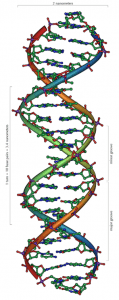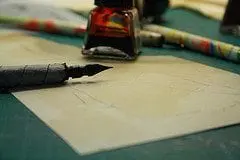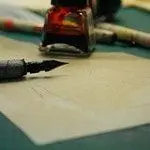By Cheri Fields

I ran into this analogy recently, but can’t remember who to credit. Here it is in my own words:
The name DNA stands for something called DeoxyriboNucleic Acid. Aren’t you glad they called it DNA for short? Every living cell has this stuff inside to tell the rest of the cell what to make and do next. You can learn how complicated it is in my FBI post.
Now, we’re going to compare it to the ink and paper a teacher hands out for an essay test.
Imagine you’re at a school in the 1700s: no pencils, no cartridges. You have to dip your quill in a bottle of ink and paper is expensive.
In order for you to pass the test, you must prove to the teacher you remember most of what was covered in each area from the last semester. No fill-in-the-blanks, no multiple choice: just the paper, your pen and ink, and your memory! Any score less than an A+ means you flunk.
That’s scary just to think about.
What if you can’t remember a thing? If you just take the ink and splash it around on the page, are you going to pass? Is there any way on the planet the teacher will be impressed with your amazing abilities?
Not a chance. You’d flunk, and so would DNA.
Random collections of fancy acid can never tell a cell how to make anything.
So there’s Abiogenesis out the window, because without every piece in place, a cell can’t live.
What if you want to get from a “simple” cell to a many-celled animal?
Maybe you remember part of what the teacher covered. After scratching away at the paper, carefully writing every detail that pops in your head, you stop dead. Not another thing comes to mind. So what do you do? Randomly rearrange what is already on the paper to form new sentences and wow the teacher?
Not without a massive bribe you don’t!
DNA can’t be randomly recombined from other genes to form brand new functioning instructions.
To have a different function, you have to plug in new information. Only someone who knows the material can add information to produce something new.
This bit is completely my idea.
What if you trade papers with the kid next to you and add his information to yours. You would do better on the test if you aren’t caught. But if neither of you had remembered anything there would have been no information to share.
You still have to start with a smart person to have anything understandable on the test.
Some bacteria and other creatures add information by combining original DNA together. But did they Evolve?
Not in the way Evolutionists need them to. Yes, their children are different and have more DNA, but they still only have information that was already there. It’s been spread around differently, but it isn’t something completely new.
For a self-writing test to work… Do I need to go on?
For Biological Evolution to be true, you have to have DNA, lots of it, from the very first cell. Then, you have to have it expand into new functions millions of times. All without any guidance or knowledge.
Or, you could start out with a super smart Creator God who can make everything “very good” from the very beginning!
I will praise you; for I am fearfully and wonderfully made: your works are marvelous; and my soul knows that for sure. Psalm 139:14








